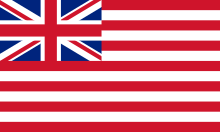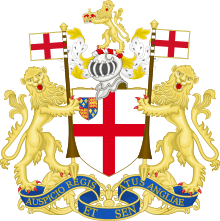Compania Britanică a Indiilor de Est
| Compania Britanică a Indiilor de Est | |
 Steagul companiei (1801) | |
 Stema companiei (1698) Motto: Auspicio Regis et Senatus Angliae "Prin comanda Regelui și a Parlamentului Angliei" | |
| Tip | Societate pe acțiuni |
|---|---|
| Soartă | Legea privind guvernului Indiei din 1858 |
| Fondată | |
| Fondator(i) | John Watts, George White |
| Desființată | |
| Țara | Regatul Unit |
| Sediu | Londra |
| Industrie | Comerț internațional |
| Produse | Bumbac, mătase, colorant indigo, sare, mirodenii, saltpetru, ceai și opiu |
| Prezență online | |
| Modifică date / text | |
Compania Indiilor de Est (engleză East India Company, East India Trading Company, sau English East India Company[1] apoi British East India Company)[2][3] a fost una dintre primele societăți pe acțiuni englezești înființată la început pentru a face comerț în Indiile de Est, dar care a ajuns să facă comerț mai ales în India și China, comercializând în principal bumbac, mătase, pigmenți indigo, salpetru, ceai și, în China, opiu.

Istoric
modificareOrigini
modificareCurând după înfrângerea Armatei spaniole în 1588, navele spaniole și portugheze capturate cu încărcăturile lor au permis călătorilor englezi să călătorească pe glob în căutarea bogățiilor.[4] Cea mai veche din mai multele companii europene formate în același scop, Compania a primit cartă regală în Anglia, sub numele de Governor and Company of Merchants of London Trading into the East Indies, de către Elisabeta I la 31 decembrie 1600.[5][6]
După ce o companie engleză rivală i-a contestat monopolul la sfârșitul secolului al XVII-lea, cele două companii au fuzionat în 1708 formând United Company of Merchants of England Trading to the East Indies (Compania Unită a Comercianților Englezi care fac Comerț în Indiile de Est), denumită frecvent Honourable East India Company, pe scurt, HEIC;[7]. Compania a fost denumită în limbajul curent John Company[8][9] iar în India Compania Bahadur (în hindustani, bahādur).[10][11]
Apogeu și declin
modificareCompania a deținut vreme îndelungată o poziție privilegiată în raport cu guvernul englez și, ulterior, cu cel britanic. Ca rezultat, a primit adesea drepturi și privilegii speciale, inclusiv scutiri de taxe și monopoluri comerciale. Acestea au determinat animozitatea concurenței, care vedea în poziția Companiei un avantaj incorect.
Compania a ajuns să guverneze părți mari din India, exercitând putere militară și asumându-și administrația, renunțând treptat la activitățile comerciale. Autoritatea acestei companii în India a început în 1757 după bătălia de la Plassey și a durat până în 1858, când, în urma revoltei indiene din 1857 și conform Legii Guvernării Indiei din 1858, Coroana Britanică și-a asumat administrarea directă a Indiei sub numele de Rajul Britanic. Compania s-a dizolvat în final la 1 ianuarie 1874.
Note
modificare- ^ Encyclopaedia Britannica 2008, "East India Company"
- ^ Columbia Encyclopedia 2007, "East India Company, British".
- ^ Marx, Karl (), „The British rule in India”, New York Daily Tribune republicat în Carter, Mia; Harlow (editors), Barbara (), Archives of Empire, Raleigh: Duke University Press. Pp. 802, ISBN 0822331640. Citat (p. 118): "I do not allude to European despotism, planted upon Asiatic despotism, by the British East India Company, forming a more monstrous combination than any of the divine monsters startling us in the temple of Salsette."
- ^ Desai, Tripta (). The East India Company: A Brief Survey from 1599 to 1857. Kanak Publications. p. 3.
- ^ „Imperial Gazetteer of India”. II. : 454.
- ^ The Register of Letters &c. of the Governor and Company of Merchants of London trading into the East Indies, 1600–1619. La pagina 3, o scrisoare a Elisabetei I din 23 ianuarie 1601 ("Witnes or selfe at Westminster the xxiiijth of Ianuarie in the xliijth yeare of or Reigne.") scrie: "Haue been pleased to giue lysence vnto or said Subjects to proceed in the said voiadgs, & for the better inabling them to establish a trade into & from the said East Indies Haue by or tres Pattents vnder or great seale of England beareing date at Westminster the last daie of december last past incorporated or said Subjecte by the name of the Gournor & Companie of the merchaunts of London trading into the East Indies, & in the same tres Pattents haue geven them the sole trade of theast Indies for the terme of XVteen yeares ..."
- ^ Hawes, Christopher J. (), Poor Relations: The Making of a Eurasian Community in British India, 1773-1833, London: Routledge. Pp. 217., ISBN 0700704256 Citat (p. xiii): "Abbreviations: Honourable East India Company (HEIC)."
- ^ Ride, Lindsay; Ride, May; Mellor, Bernard (), An East India Company Cemetery: Protestant Burials in Macao, Hong Kong: Hong Kong University Press. Pp. 304, ISBN 9622093841 Quote (p. 7): "In 1709, the Company amalgamated with a rival group, which had been chartered in 1698 by William III. This union took the title 'The Honourable East India Company,' which was shortened for general use to 'the Honourable Company' and more often still to John Company, until it ceased operations in 1834, after its monopoly of British trade with China was discontinued."
- ^ Carey, W. H. (). 1882 – The Good Old Days of Honourable John Company. Simla: Argus Press. Arhivat din original la . Accesat în .
- ^ Gandhi, M. K. (), Hind Swaraj and other writings, (Edited by Anthony J. Parel) Cambridge and London: Cambridge University Press. Pp. 208., ISBN 0521574315. Citat (p.39): "... They came to our country originally for the purpose of trade. Recall the Company Bahadur.† Who made it Bahadur? They had not the slightest intention at the time of establishing a kingdom. Who assisted the Company's officers? Who was tempted by their silver? Who bought their goods? History testifies that we did all this. ... †: 'the Company Bahadur': an honorific title by which the East India Company was known among Indians. 'Bahadur' means brave, powerful, sovereign."
- ^ „"Company Bahadur"”. Encyclopaedia Britannica.